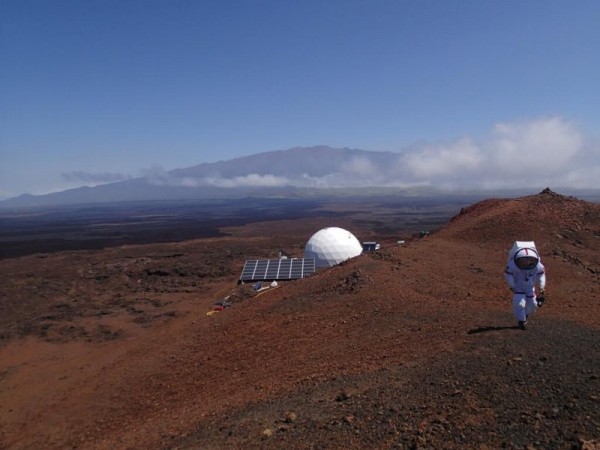By Ana Verayo, | January 23, 2017

Six scientists have entered an isolation dome inside a Hawaiian volcano to simulate Martian environment and conditions. (University of Hawaii HI-SEAS)
Six scientists are living inside a dome inside a Hawaiian volcano as part of a NASA Mars simulation program to study human behavior and also to prepare for the next manned mission to the Red Planet.
This carefully selected team of four men and two women began living inside the simulated space dome last week Thursday. The dome is located on Hawaii's Mauna Loa. This astronaut shelter measures 1,200 square feet or around the size of small two bedroom home.
Like Us on Facebook
The team will spend a total of eight months in this vinyl-covered Mars simulation space dome called HI-SEAS (Hawaii Space Exploration Analog and Simulation).
This means that they are not allowed to have any physical contact with anyone from the outside world. The only people that they are allowed to communicate with are the mission support crew. However, there will be a 20-minute delay in their interaction. This 20-minute delay is the amount of time that it takes for an email from Earth to travel to Mars.
NASA will be studying the physiological and psychological challenges that scientists will face while living in isolation. Hawaii has been chosen as the location for Mars simulation projects due to its rugged and dry Martian-like landscape along with its rocky, red plains near the world's largest active volcano.
This special team is composed of engineers, a biomedical expert, a computer scientist, and a doctoral candidate. They were chosen from 700 applicants based on multiple personality tests, extensive interviews, and background checks.
The HI-SEAS dome includes small sleeping quarters for each member as well as a kitchen, a laboratory, and a bathroom. The dome is opaque and not translucent or transparent, unlike the other simulation projects.
The crew will eat freeze-dried foods and canned goods and snacks, including Spam. To simulate Martian isolation, food cargo supplies will be transported to them from a considerable distance. The team will control a robot to retrieve this package.
When they step outside their dome, the members of the crew are required to wear spacesuits for geological expeditions and mapping studies.
The crew members are wearing instruments to measure their moods and proximity to other team members. They will also use virtual reality devices to simulate a comforting and familiar environment to be able to survive this mission.
Past projects involved scientists living in this dome. One of them lasted a year, and another one lasted for eight months to study food and nutrition requirements for crew members and how the crew can work with one another.
"We are also hoping to figure out how to select the best astronauts for this mission and how to support a crew for long-term spaceflights and missions," principal investigator, Kim Binsted of the University of Hawaii, said.
NASA is planning to send humans to an asteroid in the early 2020s and to Mars by the 2030s.
-
Use of Coronavirus Pandemic Drones Raises Privacy Concerns: Drones Spread Fear, Local Officials Say

-
Coronavirus Hampers The Delivery Of Lockheed Martin F-35 Stealth Fighters For 2020

-
Instagram Speeds Up Plans to Add Account Memorialization Feature Due to COVID-19 Deaths

-
NASA: Perseverance Plans to Bring 'Mars Rock' to Earth in 2031

-
600 Dead And 3,000 In The Hospital as Iranians Believed Drinking High-Concentrations of Alcohol Can Cure The Coronavirus

-
600 Dead And 3,000 In The Hospital as Iranians Believed Drinking High-Concentrations of Alcohol Can Cure The Coronavirus

-
COVID-19: Doctors, Nurses Use Virtual Reality to Learn New Skills in Treating Coronavirus Patients








